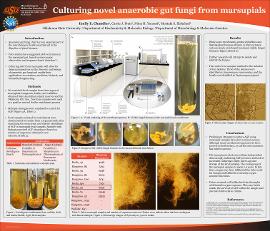| dc.contributor.advisor | Elshahed, Mostafa S. | |
| dc.contributor.author | Chandler, Emily E. | |
| dc.contributor.author | Pratt, Carrie J. | |
| dc.contributor.author | Youssef, Noha H. | |
| dc.date.accessioned | 2022-04-13T14:44:31Z | |
| dc.date.available | 2022-04-13T14:44:31Z | |
| dc.date.issued | 2022-04-19 | |
| dc.identifier | oksd_URS_2022_chandler | |
| dc.identifier.citation | Chandler, E. E., Pratt, C. J., Youssef, N. H., & Elshahed, M. S. (2022, April 19). Culturing novel anaerobic gut fungi from marsupials. Poster session presented at the Oklahoma State University Undergraduate Research Symposium, Stillwater, OK. | |
| dc.identifier.uri | https://hdl.handle.net/11244/335228 | |
| dc.description.abstract | Anaerobic gut fungi (AGF) from the phylum Neocallimastigomycota are an essential part of the microbiome in herbivores. These fungi aid in digestion in ruminants, pseudoruminants, and nonruminants alike, where they adhere to plant biomass and produce enzymes and bioactive molecules that break down complex sugars. This includes the degradation of cellulose, which is essential in the development of biofuels and other biotechnologies converting plant biomass to products of commercial value. Marsupials, non-placental mammals who split from placental mammals ~125 Mya, have shown strong microscopic and sequence-based evidence for harboring AGF. Marsupial herbivores are promising hosts for uncovering novel AGF because some species are foregut fermenters (kangaroos and wallabies) and others are hindgut fermenters (koalas and wombats), both digestive methods that are associated with AGF presence in other herbivores. Due to their laborious maintenance procedures, strict anaerobic nature, and technical difficulties in genomic sequencing, these microorganisms are under-researched and poorly sampled. | |
| dc.description.abstract | We hypothesized that marsupials represent a yet-untapped reservoir for discovering novel AGF taxa. To test this hypothesis, we collected fresh fecal samples from a wide range of marsupials and are currently attempting to enrich and isolate novel AGF taxa from these samples. Using complex media amended with plant substrates, strict anaerobic techniques, and multiple antibiotics for suppressing growth, we were able to enrich for AGF, as evident by visual production of hyphal filaments in enrichment tubes. We are currently undertaking purification procedures to isolate axenic cultures of AGF for subsequent identification and characterization. Culturing novel AGF from marsupials will allow for deeper perspectives on the diversity and biology of anaerobic gut fungi and will enable their applications in veterinary medicine, biofuels, and biomedical engineering. | |
| dc.format | application/pdf | |
| dc.language | en_US | |
| dc.publisher | Oklahoma State University | |
| dc.rights | In the Oklahoma State University Library's institutional repository this paper is made available through the open access principles and the terms of agreement/consent between the author(s) and the publisher. The permission policy on the use, reproduction or distribution of the article falls under fair use for educational, scholarship, and research purposes. Contact Digital Resources and Discovery Services at lib-dls@okstate.edu or 405-744-9161 for further information. | |
| dc.title | Culturing novel anaerobic gut fungi from marsupials | |
| osu.filename | oksd_URS_2022_chandler.pdf | |
| dc.description.department | Biochemistry and Molecular Biology | |
| dc.description.department | Microbiology and Molecular Genetics | |
| dc.type.genre | Poster | |
| dc.type.material | Text | |
| dc.type.material | Image | |
| dc.subject.keywords | anaerobic gut fungi | |
| dc.subject.keywords | AGF | |
| dc.subject.keywords | phylum Neocallimastigomycota | |
| dc.subject.keywords | marsupials | |
| dc.subject.keywords | gut microbiome | |
| dc.subject.keywords | biofuels | |
